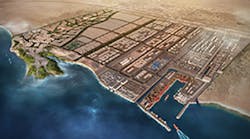[Case history] Greenfield offers continuous monitoring of assets in real time
Run-to-failure is increasingly reserved for rare and unique circumstances. This trend started when increasingly capable condition inspection and monitoring tools shifted the asset management focus from “fix what’s broken” to “keep it from breaking down.” Today, unprecedented opportunities afforded by the industrial internet of things (IIoT) have further changed the playing field, and there are potential benefits yet to be realized.
For example, predictive maintenance (PdM), originally based on selected asset condition data, has grown to accommodate online, real-time streams of multiple types of condition data received via sensors and even drones. Some companies are applying machine learning (ML) to further refine their predictive analytics and prognostics.
The newest opportunity, prescriptive maintenance (RxM), is a multivariate approach that merges asset condition data with any combination of operating, environmental, process safety, engineering, supplier, or other related data to better diagnose conditions and prescribe specific options for corrective action. The advanced analytics, pattern recognition, modeling, ML, and artificial intelligence (AI) that empower RxM may help companies finally greatly curtail, if not eliminate, the need for reactive maintenance on critical equipment.
- Read all 7 case histories from our April 2019 cover story, "How 7 companies are accelerating PdM and RxM at their plants."
Saudi Aramco’s Jazan Refinery Complex is a greenfield megaproject expected to begin operations in 2019. Different tools are being used within the new site’s integrated manufacturing operations management system (imoms) to manage the end-to-end manufacturing business processes and monitor the health of different equipment types in real time, including rotating, instrumentation, and critical static equipment, says Eyad Buhulaiga, senior projects manager at Saudi Aramco.
The tools utilize mechanisms such as ML to predict equipment health anomalies at an early stage and to determine when the maintenance should be performed to avoid failure. Another mechanism ensures the assets are running within their optimum operating window, without unacceptable violations to equipment limitations.
Condition monitoring and predictive health tools built into Saudi Aramco’s integrated manufacturing operations management system (imoms) help ensure that assets are running within their optimum operating window, without unacceptable violations to equipment limitations.
“Continuous monitoring of the assets in real time, to ensure that they are operated with the least possible risks (as low as reasonably practicable, or ALARP), includes defining the asset integrity levels, safety critical elements, performance standards, assurance tasks, etc.,” says Buhulaiga. Any deviation of these parameters will be reported immediately in order to take the recommended measures. This will significantly enhance the PdM and RxM activities by injecting more data that is relevant to the asset, and hence, the activities will be focused on the items that require attention, he explains.
For instance, through the different tools and methodologies within imoms, a combustion liner failure in a turbine can be predicted three weeks in advance. This knowledge will lead to reduced or avoided damage to the critical equipment, improved process safety, and avoidance of unexpected shutdowns.
“Before implementation of PdM and RxM, it is important to identify the business goals, road map, and top-priority assets, where the relevant data is available,” recommends Buhulaiga. “Engage the right stakeholders to ensure smooth and sustained implementation and usability.”


